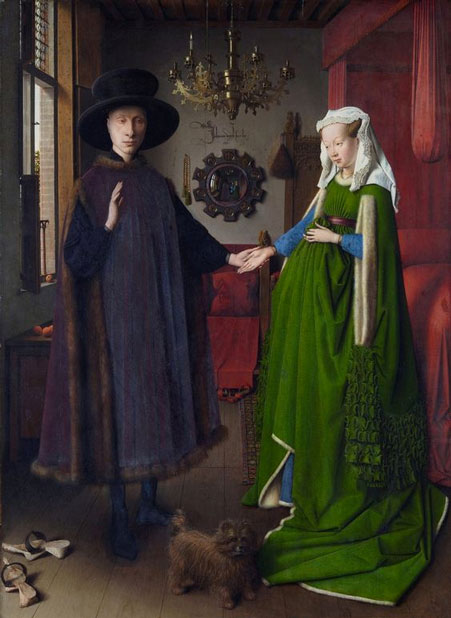
The Arnolfini Portrait is a 1434 oil painting on oak panel by the Early Netherlandish painter Jan van Eyck. It forms a full-length double portrait, believed to depict the Italian merchant Giovanni di Nicolao Arnolfini and his wife, presumably in their residence at the Flemish city of Bruges.It is considered one of the most original and complex paintings in Western art, The painting was bought by the National Gallery in London in 1842.Van Eyck used the technique of applying several layers of thin translucent glazes to create a painting with an intensity of both tone and colour. The glowing colours also help to highlight the realism, and to show the material wealth and opulence of Arnolfini's world. Van Eyck took advantage of the longer drying time of oil paint, compared to tempera, to blend colours by painting wet-in-wet to achieve subtle variations in light and shade to heighten the illusion of three-dimensional forms. The wet-in-wet, technique, also known as alla prima, is highly utilized by Renaissance painters including Jan van Eyck.The medium of oil paint also permitted van Eyck to capture surface appearance and distinguish textures precisely. He also rendered the effects of both direct and diffuse light by showing the light from the window on the left reflected by various surfaces.The illusionism of the painting was remarkable for its time, in part for the rendering of detail, but particularly for the use of light to evoke space in an interior, for "its utterly convincing depiction of a room, as well of the people who inhabit it".Whatever meaning is given to the scene and its details, and there has been much debate on this, according to Craig Harbison the painting "is the only fifteenth-century Northern panel to survive in which the artist's contemporaries are shown engaged in some sort of action in a contemporary interior. It is indeed tempting to call this the first genre painting – a painting of everyday life – of modern times".
Comments
Add Comment